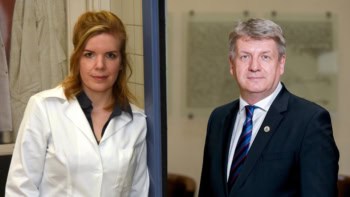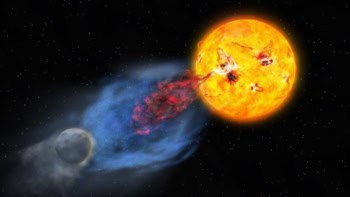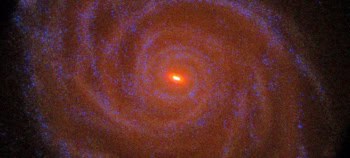With NASA’s James Webb Space Telescope finally launched, Keith Cooper explores the mission’s troubled past, its technological advances and the exciting future ahead for astronomy

The original deep-field image taken by the Hubble Space Telescope is one of the most iconic images in astronomy. Consisting of a mind-boggling number of distant galaxies set against a blanket of black, the picture is constructed via a series of observations that Hubble made in December 1995 of a small region in the constellation Ursa Major. Inspired by this timeless image, astronomers began planning a new mission to study the early universe – one that would see even further back in time, to 300 million years after the Big Bang when some of the first galaxies existed. But to do so required the biggest observatory ever to be conceived, one much larger than Hubble’s 2.4 m mirror. The answer: the Next Generation Space Telescope (NGST) – a huge spacecraft with a 6.5 m segmented primary mirror that promised a whole raft of new discoveries.
Excited by the NGST’s potential, US astronomers soon selected it as top priority for space-based missions in the 2000 Decadal Survey – a wishlist of future projects compiled by the US National Academies of Sciences, Engineering, and Medicine. Pegged for launch in 2007 at a cost of $1bn, in 2002 it was renamed the James Webb Space Telescope (JWST) after the former NASA administrator. Yet those dreams of a new telescope to study the evolution of galaxies and how stars and planets form quickly turned into a nightmare. The project’s budget spiralled so much that in 2011 the US House of Representatives moved to cancel it entirely, only for the troubled project to receive an eleventh-hour reprieve after scientists, the public and the media rallied to save it. As recently as 2018, when the cost was about to break the $8bn barrier, US Congress had to vote to provide it with more funds.
The JWST is now estimated to cost $9.7bn and part of the reason behind those ballooning costs was building a telescope of its enormous size. At 6.5 m, the JWST’s segmented primary mirror is the largest ever sent into space. “When we started, we knew that we could more safely build a much smaller telescope,” says John Mather, the Nobel-prize-winning cosmologist who has been leading the project at NASA’s Goddard Space Flight Center since the mid-1990s. The problem, though, was that smaller wouldn’t do to carry out the transformative science that astronomers wanted.
The problem, though, was that smaller wouldn’t do to carry out the transformative science that astronomers wanted
And size was not the only tough requirement. The light from those early galaxies has been stretched by cosmic expansion. To see them, astronomers need a scope that can peer into near- and mid-infrared wavelengths. And to do that, the telescope needs to be stationed away from Earth’s thermal glow, around the L2 Lagrange point, with the Moon and Earth behind it. “Another thing is that to reach the infrared sensitivity that we need, the telescope has to be very cold,” Mather says. “Pretty soon you have a heck of a lot of hard technical challenges.”
Two decades of developmental hell have now passed and the JWST is finally ready to make its grand entrance. For most of the astronomy community, the spacecraft could not get off the ground soon enough. The scope was finally launched on 25 December 2021, at 7:20 a.m. EST from Europe’s Spaceport in French Guiana, South America – a long-awaited Christmas present for astronomers everywhere. Yet even once the payload was hurled skyward atop a column of fire aboard an Ariane 5 rocket, mission scientists did not immediately exhale in relief. While launch is usually the most dangerous part of a space mission, that is not the case with the JWST.
For NASA’s latest and most expensive eye in the sky, launch was the simple part. That is because before it can push the envelope of what science and space technology can achieve, it had to first overcome a dangerous deep-space unpacking: its 6.5 m primary mirror had to carefully unfold correctly and its tennis-court-sized sunshield needed to unfurl – a key step of this task was perfectly achieved on 28 December. During this deployment period – which is still ongoing and will take a total of about 30 days to complete – if any of more than 300 things that could go wrong, do go wrong, the telescope’s capabilities will be limited at best. In the worst case scenario, the entire instrument could have been ruined, setting the field back decades. If it continues to succeed without a hitch, it should transform astronomy – all thanks to several technological marvels that make the JWST a unique and powerful instrument.
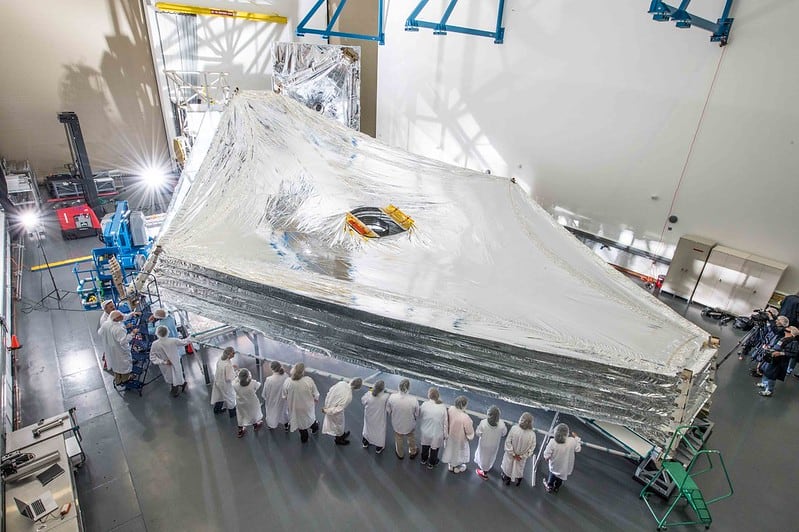
Mirror symmetry
One of the biggest challenges facing engineers in building the JWST was the mission’s 6.5 m primary mirror. Constructing a mirror that size isn’t a problem per se, but it is an issue to fit it inside an Ariane 5 rocket that is just 4.57 m wide, without being too heavy to launch into space. The task of solving this particular issue fell to Lee Feinberg, the optical telescope element manager at NASA Goddard. “The primary mirror has a very elegant design,” says Feinberg. The essence of that design, he explains, is that the mirror is foldable: it comprises 18 hexagonal segments, with three of the segments on either side forming “wings” that fold out.
The JWST also has a secondary mirror 0.74 m across, plus a smaller tertiary mirror to remove the scope’s astigmatism and flatten the focal plane ready for its scientific instruments. Together, these three mirrors make up an arrangement known as an “off-axis three-mirror anastigmat” that corrects for spherical, coma and astigmatism errors, while providing the instrument with a larger field of view. But these capabilities contribute launch headaches of their own. “The real trick is that the booms holding the secondary mirror are 8 m long, so you also have to fit that inside the rocket,” Feinberg notes. “And then there’s the sunshield. So we had to fold up for all those reasons.”
The mirrors are made from a new type of gold-plated, optical-grade beryllium that remains stable at the telescope’s operating temperature of 36 K. This material, known as O-30, was created especially for the JWST by the materials firm Materion, and its advantages include a low mass and good technical performance at cryogenic temperatures. The material’s stiffness, for example, means that when the mirror is plunged into the freezing cold behind the telescope’s sunshield, it does not distort too much. Given all these factors, and the size of beryllium billets that were considered reasonable to work with, making a hexagonal segmented system that could fold up was “the best option”, Feinberg says.
A similar hexagonal system has operated on the twin 10 m Keck telescopes in Hawaii since the 1990s, and Feinberg acknowledges that his team learned a lot from Keck’s optical design. As at Keck, all 18 segments of the JWST’s primary mirror, as well as its secondary, have robotic actuators to nudge them into focus. However, while Keck has sophisticated wavefront sensors to align its segments, the JWST optical team decided that such a system would be too complex to operate autonomously in deep space. Instead, the telescope will use its science camera. “The first test image that we’ll get will actually be 18 separate stars, because of the 18 separate segments each acting like a telescope,” Feinberg explains. The telescope will then use its camera and a specially developed algorithm called “phase retrieval” to measure the shape of the wavefront and adjust the shape of the primary mirror until all 18 segments focus as one.
The design of the telescope’s mirrors is typical of the technology and techniques that had to be pioneered to make the JWST workable. “Across the board, we felt that for everything we did, there was no playbook,” Feinberg says. “We were really changing the way we were doing things.” A case in point: while the 2.4 m mirror on Hubble is contained within what is effectively a giant telescope tube assembly, the JWST’s mirrors are open to space. And protecting these mirrors from the heat and glare of the Sun is a tough challenge.
Transforming science – offering new views of other worlds

Delays to the James Webb Space Telescope (JWST) may have been a headache for NASA administrators, but they offered astronomers the chance to change the telescope’s mission beyond recognition. In the mid-1990s exoplanet science was in its infancy but during the JWST’s lengthy sojourn in development hell, NASA’s Kepler and TESS spacecraft, among others, got on with the business of discovering new planets outside our solar system. “People were just starting to make the first observations of [exoplanets], so we asked, how can we use [the JWST] to see them?” says John Mather from NASA’s Goddard Space Flight Center. “We now have our list of transiting exoplanets, and we wouldn’t have had that list even a few years ago – that’s a pretty clear benefit of being late.”
The JWST’s main exoplanet task will be to probe the atmospheres of these distant worlds as they pass between the telescope and their parent stars. During these transit events, the atoms and molecules in the exoplanet’s atmosphere will absorb some of the light from the parent star, creating telltale gaps in the star’s spectrum that the JWST can detect. And thanks to that painstakingly compiled target list, Mather says, they won’t have to be lucky to spot one. “We now know where to look for transiting exoplanets, and exactly when to look,” he adds.
Today we know of thousands of worlds beyond our solar system, and – all being well – the JWST will be in prime position to study their atmospheres. Indeed, nearly a third – 70 out of 286 – of the science proposals chosen for cycle 1 of JWST operations are related to exoplanets. One of the worlds that will fall under the JWST’s gaze during its first cycle of science observations is the hot, rocky planet LHS 3844b, which could harbour the first known volcanoes outside our solar system. Then there’s 55 Cancri e, a super-Earth with “weather” that may include lava raining from the sky, and HD 189733b – a hot, Jupiter-like planet that may have clouds and rain made from vaporized minerals. Astronomers are also keen to study a relatively young exoplanet, CT CHa b, which may be surrounded by a disc of gas and dust that is gradually accreting onto its surface.
A further target is the TRAPPIST-1 system, which consists of seven terrestrial exoplanets orbiting a red dwarf star 40 light-years away. Astronomers are planning to use the JWST to scrutinize this system in several ways, including a general reconnaissance of all seven worlds and two sets of observations on its third planet, TRAPPIST-1c, which may be in the system’s so-called habitable zone, where conditions may allow water to exist as a liquid on or near the surface. With many of these transiting, habitable-zone planets, the JWST will be looking for biomarkers – the absorption signatures of oxygen, water, carbon dioxide, ozone, methane and indeed anything else that could be produced by living creatures or indicate a potentially life-supporting environment. But the telescope’s exoplanet studies will go deeper, too. Using its infrared instruments, the JWST will peer into the dusty confines of star-forming nebulae and circumstellar discs around young stars, collecting data that should give scientists a better idea of how new planetary systems form.
Sun factor
As the JWST operates in infrared light, stray thermal emissions from the Sun, Earth and even the spacecraft itself could cloud its vision. To keep them out, mission scientists designed an intricate, tennis-court-sized sunshield that is quite unlike anything NASA has attempted to deploy in space before. The sunshield comprises five layers, or membranes, of an aluminium-coated polymer called Kapton that is widely used in space exploration thanks to its stability across a broad range of temperatures. This stability is crucial: the first, Sun-facing layer of the shield is expected to reach 383 K, while temperatures at the inner fifth layer will drop as low as 36 K. Even with the right material, though, designing the sunshield’s layers to perform in deep space has been “a significant concern” says James Cooper, the JWST’s sunshield manager at NASA Goddard.
Part of the problem is that each membrane in the sunshield will expand or contract to a different degree depending on its operating temperature. Accordingly, the membranes that sat in a clean room at Northrop Grumman – the aerospace firm that designed and built the sunshield – were not the same size as they are in space. “Each membrane is carefully sized for its predicted temperature range,” Cooper explains. “Layer one – the Sun-facing layer – will be the hottest, while layer five will get very cold. So layer five has to be built ‘too big’ on Earth because we know that the material will shrink when it gets cold.”
Another challenge is that each layer of the sunshield is gossamer-fine. The first, hottest layer is 0.05 mm thick, while the other four are 0.025 mm; their aluminium coatings are just 100 nm deep. Keeping the membranes thin saves weight, but it could also leave the sunshield susceptible to damage. Indeed, the shield is designed to cope with some level of damage and engineers expect it to suffer various wounds from micrometeorite impacts during its working life. Cooper says that the odd hole here or there will not affect its performance – especially since they built a grid of seams and rip-stops into each layer to prevent tears from growing larger than approximately one by two metres. “We can meet performance requirements with this size tear in any layer,” adds Cooper.
The greatest risk of damage, though, came, and thankfully passed, soon after launch. Each of the kite-shaped sunshield’s six corners contains a membrane tensioning system (MTS), and each MTS is attached to 15 cables – three for each of the five membranes, amounting to 90 cables in all. To pull the sunshield’s five layers apart, the MTSs had to reel these cables in. A rip or catch at this unfurling stage could have been very damaging and getting the system to work in rehearsals had proved tricky. “The MTS was relatively straightforward when bench-tested alone, but when we put everything together we found complex interactions with the membrane and cable-management systems,” Cooper says. “We had to overcome challenges dealing with alternating tensions and slack in the cables.”
As the sunshield began unfurling three days after the telescope’s Christmas day launch, and took eight days to complete, it was a nervy time for the team, which ended happily, with its successful unfolding. But the sunshield engineers were not the only ones biting their fingernails about keeping the JWST cool. While the sunshield will keep the telescope’s optics and most of its instruments at a frigid 36 K, some components need to be even colder.
Keeping cool
Of the four instruments aboard JWST, three – the Near Infrared Spectrograph (NIRSpec), the Near-Infrared Camera and the Fine Guidance Sensor/Near Infrared Imager and Slitless Spectrograph – operate at near-infrared wavelengths of 0.6–5 μm. For them, the telescope’s general, solar-shielded operating temperature of 36 K is cold enough. The fourth instrument, however, is designed to observe at longer wavelengths of 5–28 μm. For that, it needs even lower temperatures – 29 K colder than the other instruments, to be precise. To keep the arsenic-doped silicon detectors on the Mid-Infrared Instrument (MIRI) at their operating temperature of 7 K, NASA has built the most sophisticated cryocooler ever launched into space. To call it a big refrigerator would be simultaneously accurate and a gross disservice to the innovations required to make it work.
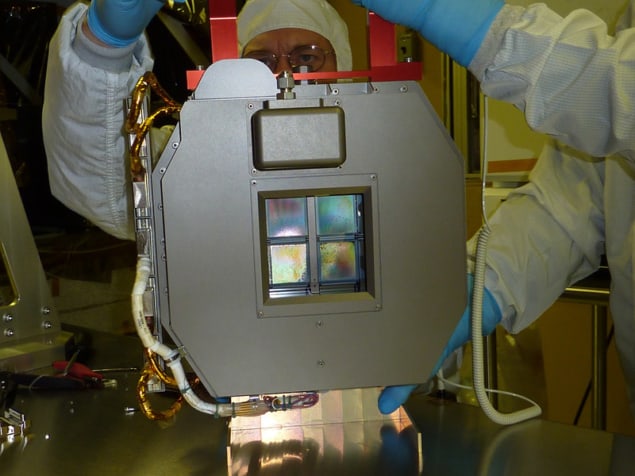
However, unlike two of its predecessors, NASA’s Spitzer Space Telescope and the European Space Agency’s Herschel Space Observatory, it will not run out of coolant, because its cryocooler is a closed system. The cryocooler’s main section is its Cryocooler Compressor Assembly (CCA). Housed in the spacecraft bus, on the warm side of the telescope, it uses helium as a refrigerant, and is connected to MIRI (located about 10 m away in the Integrated Science Instrument Module, behind the telescope’s primary mirror) by a labyrinth of tubes. Once the helium has been conductively chilled by a precooler inside the CCA, it gets pumped through these tubes to MIRI via the Cryocooler ColdHead Assembly. This device contains a valve less than a millimetre wide that acts as a “throttle” for the helium. As the helium expands on the other side of the valve, it drops to 6 K (one degree below MIRI’s operating temperature) thanks to the Joule–Thomson effect. It then passes behind MIRI’s detectors, picking up and exchanging their excess heat.
In a terrestrial cryocooler, such a system would be straightforward. In a cooler located on board a telescope in deep space, however, it creates certain challenges. An example is the distance between the pre-cooler and the helium-throttling valve. Normally, these two components are just centimetres apart, but on the JWST they are separated by many metres. Keeping the helium refrigerant cool on its journey though the telescope’s plumbing is therefore vital. Another challenge is vibration. Any cryogenic system that contains moving parts will produce some vibrations, but aboard the JWST these vibrations need to be virtually non-existent, since any jitter from moving machinery could shake the optics and produce blurred images. Consequently, the JWST’s cryocooler contains only two moving parts: a pair of horizontally opposed piston pumps in the CCA that are specially designed to operate with exceptional smoothness.
Transforming science – seeing deeper into the universe than ever before
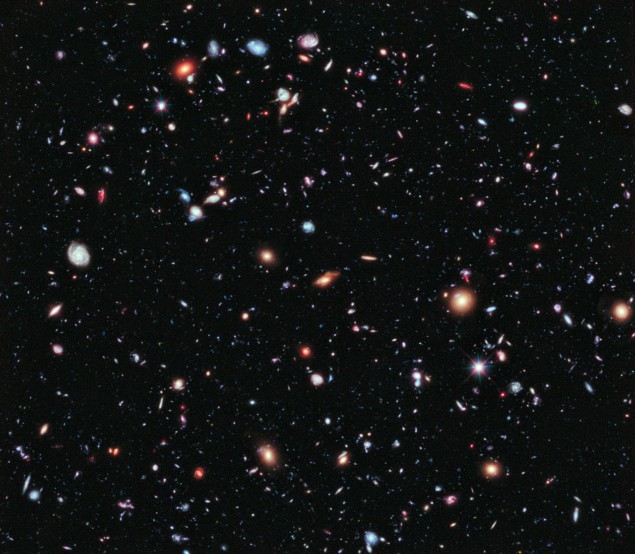
One of the main scientific tasks on the James Webb Space Telescope (JWST) will be to revisit the Hubble deep fields. These famous images are the product of the Hubble Space Telescope’s most penetrating gazes into our universe’s past, recording light emitted up to 13.2 billion years ago and redshifted by as much as a factor of 12 as the expansion of the universe carries these old, distant galaxies away from us. Thanks to its larger primary mirror (6.5 m compared to Hubble’s 2.4 m), the JWST will be able to see even further back in time, routinely imaging objects at redshift 15 and occasionally seeing some at redshifts between 25 and 30, according to John Mather from NASA’s Goddard Space Flight Center.
Objects at these redshifts will appear as they existed up to 13.5 billion years ago, just 300 million years after the Big Bang. Any galaxies among them would be some of the very first to exist, which could make them hard to spot: the currently favoured model of galaxy formation involves smaller galaxies colliding and merging with each other to form larger ones, meaning that the earliest galaxies are predicted to be small and faint. Nevertheless, Mather is confident that imaging them is within the JWST’s reach. “They’re not expected to be common, they may be a little hard to find, and we may need some luck to find them, but we’ll certainly be looking,” he says.
Seeing the first galaxies is only one part of the equation. Astronomers also want to understand galaxies’ full lifecycle, from their formation all the way through to the present day. The JWST will have a role here, too, making observations of galaxies throughout time that will help build a more complete picture of how elliptical and spiral galaxies develop and how star formation spurs their physical and chemical evolution. The telescope will also explore the role of dark matter in bringing galaxies together, and the effects of feedback from active black holes in controlling star formation.
With so many topics to investigate, Mather says the hardest part for astronomers may be waiting for mission scientists to get to grips with the telescope’s quirks. “The Hubble deep fields will be hard to do better, because we know from Hubble that when you try to take lots of time exposures and average them together, things can go wrong,” he says. “We have to learn what those things might be before we invest the amount of time in something so precious.”
A new vista
The JWST is not the only major astronomy facility due to come online in the 2020s. In fact, it is one of three: the Vera C Rubin Observatory will see first light in Chile in 2022, while the Nancy Grace Roman Space Telescope is currently scheduled to launch in 2027. Both facilities will be leaders in all-sky survey work, where the emphasis is on observing as many objects as possible across a wide swathe of sky. Such surveys are vital for collecting data on large numbers of objects. Among other projects, they will provide the statistics behind efforts to measure the strength of dark energy.
The current leader in this field is the Nicholas U Mayall four-metre telescope at Kitt Peak National Observatory, where the Dark Energy Spectroscopic Instrument (DESI) can make 5000 spectroscopic observations at once. That figure is well beyond the JWST’s capabilities, but the new space telescope will nevertheless do its fair share of astronomical surveying thanks to NIRSpec. This instrument can collect spectroscopic data on 100 objects at once, granting the JWST a capability that no other space telescope has ever had and giving astronomers a fresh eye for their surveys.
To make the JWST fit for survey work, its designers had to look beyond the technology already in use at DESI. In the past, making simultaneous observations was a laborious process, one that involved manually fixing optical fibres at holes punched in an aluminium plate. DESI avoids this thanks to robotic actuators that position the fibres anywhere across the instrument’s field of view and can be moved every 20 minutes, allowing a huge number of observations to take place in a single night. Unfortunately, this solution was deemed unworkable for a space-based observatory. “We looked at DESI’s robotic fibres when we were choosing what to do on [the JWST], and we were completely in awe of the robotic capabilities that it would take to do that in space,” Mather told Physics World.
With robotic actuators unable to operate to extremely high precision at the JWST’s cryogenic temperatures, and no human technicians available to change the position of its optical fibres manually, Mather and his colleagues needed a different solution. In fact, they needed a solution that didn’t involve optical fibres at all, since “there are no optical fibres that would cover the whole range of wavelengths that we want to cover”, he explains.
The NIRSpec team’s answer is an ingenious one. The instrument’s focal plane is divided into four quadrants, each about the size of a postage stamp and filled with 62,000 microshutters. Each microshutter measures just 100 × 200 μm and is made from silicon nitride, which has a high tensile strength and is tough enough for the shutters to open and close many times without fatiguing. During each observation, the shutters that need to open will receive an electrical signal from a magnetic arm that sweeps over the quadrants. This system will allow the JWST to study the spectra of thousands of the most distant galaxies during its mission, learning about their chemistry, star-formation rates, redshifts and more. “There’s a couple of hundred scientific proposals that we’re going to do in the first year,” says Feinberg, “and each one is at a level where they could justify a whole mission in themselves.”

NASA launches flagship $10bn James Webb Space Telescope
While there are many comparisons between Hubble and the JWST, there are also many differences. Not least of these is where the telescope operates from. When Hubble’s 2.4 m primary mirror had been ground to incorrect specifications – unknown to engineers at the time – it resulted in spherical aberration. NASA astronauts then conducted a daring space walk in 1993 where they successfully installed a new instrument to give Hubble a new pair of eyes. Hubble is in Earth orbit, which is not the case for the JWST’s position at L2 – much too far for astronauts to reach it on a servicing mission.
While there are many unknowns about how long the JWST will operate for, if all goes to plan during unpacking in the coming weeks and months, then at least from a cooling perspective, the JWST should be fit to see out the coming decade. It will then be able to operate alongside many other ground- and space-based instruments that are scheduled to come online in the mid- to late-2020s – just as Hubble had done in previous decades with other observatories. Astronomers may have waited decades for the telescope to be realized, but once it begins transforming our view of the universe, it promises to be worth the wait.
- A version of this article was first published online on Physics World as a blog series starting on 17 December 2021.

